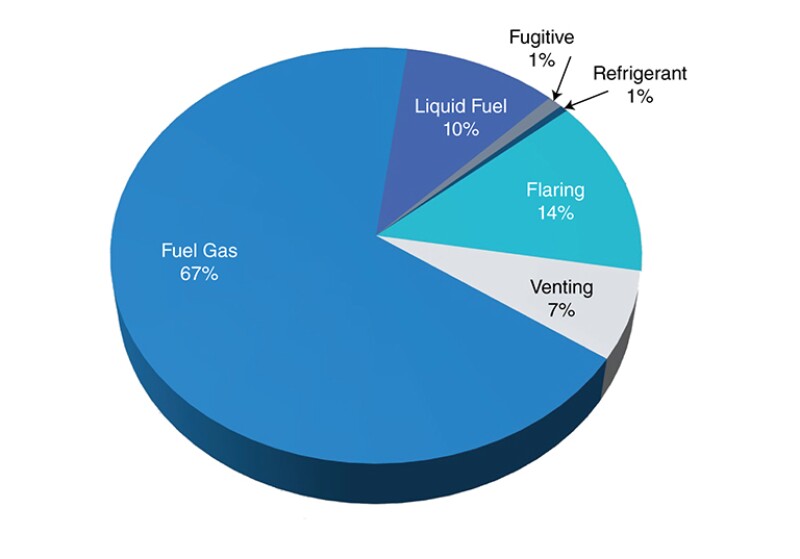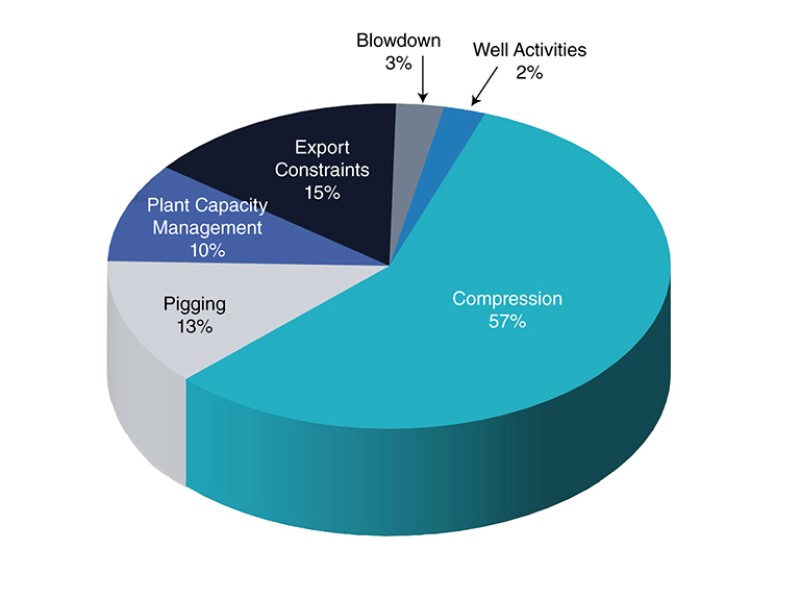Global energy-industry-related carbon dioxide (CO2) emissions rose by 6% in 2021 to 36.3 billion tons, the highest-ever level, as the world economy rebounded strongly from the COVID-19 crisis, according to an International Energy Agency (IEA) report.
Combined with the methane emissions estimates that the IEA published earlier this year and estimates of nitrous oxide and flaring-related CO2 emissions, the new analysis shows that overall greenhouse-gas (GHG) emissions from the energy industry also rose to their highest-ever level in 2021—40.8 Gt of CO2 equivalent (CO2eq).
In the Middle East, decarbonization initiatives are gathering pace as environmental regulations become stricter around the world and companies are vying to be at the forefront of emission-reduction initiatives. While CO2 emissions in the Middle East are less compared with those in other regions, these oil- and gas-producing countries are under pressure to enhance their climate-change measures further.
Background and Challenge
A thorough understanding of a company’s current GHG footprint is fundamental in identifying effective emissions-reduction opportunities and design a pathway to net zero by 2050. This baseline serves as the foundation for planning and ensures consistent tracking of progress moving forward. Energy consultancy Xodus was invited by a major Middle Eastern operator to carry out an in-depth review of Scope 1, 2, and 3 GHG emissions across its entire portfolio and to establish the foundations for the development of a fact-based, achievable, and sustainable emissions‑reduction plan.
The study had several challenges to overcome to ensure a reliable and representative outcome was achieved, including the large number of assets, interconnected production, and power sharing, as well as factors such as lack of metering and data availability. Utilizing its extensive experience in the carbon-reduction space to combine traditional engineering and unconventional approaches, the company established a robust emissions baseline.
An extensive three-part work scope was carried out.
- Desktop review to identify, quantify, and fully understand all Scope 1, 2, and 3 emissions sources and validate current baseline estimations, and identifying gaps and opportunities to improve future measurement and reporting
- Review of guidance, legislation, and policy at national, international, and stakeholder levels against current internal processes, and identifying best practices, peer benchmarking, and recommendations for the development of an internal GHG emissions and energy-efficiency framework
- Offshore site surveys to carry out “hands-on” energy and emissions assessments and identify emissions-reduction opportunities
The Approach
The company worked collaboratively with the client to deliver a study that strengthened their team’s understanding of Scope 1, 2, and 3 emissions and laid the foundations for the development of a robust GHG emissions and energy-efficiency framework to realize their net‑zero goals.
Typically, this process begins by establishing an asset-specific emissions profile followed by a series of facilitated workshops to review the asset-emissions sources and to identify energy- and emissions-reduction opportunities. These findings are then ranked to create a master plan of potential opportunities and their associated costs and CO2eq savings.
The study focused on two key elements: a review of national, international, and shareholder policies and guidance and a technical identification and a review of emissions sources. Both elements included a review of the current position, peer and best practice benchmarking, and ultimately a list of recommendations and improvements.
The legislation and guidance review consolidated information from a variety of wide-ranging sources to develop structured recommendations, including but not limited to
- National-level policy, strategy, and laws around GHG accounting and reporting.
- The current GHG accounting and reporting practices of company shareholders.
- Current Scope 1, 2, and 3 boundaries compared with recommended industry best practices.
- The role of the UN Intergovernmental Panel on Climate Change in identifying the types of GHG and their global-warming potentials.
- International and sector “good practice” standards and guidelines.
- Developing guidance and recommendations for GHG inventory identification and accounting.
The technical review of GHG emissions identified and quantified all sources of emissions allowing for comparison and validation of current emissions reporting, identification of gaps, and making recommendations for improvements.
A detailed piping and instrumentation diagram (P&ID) review was undertaken to identify all sources of Scope 1 GHG emissions, including the combustion of fuel gas and liquid fuels, gas flaring, atmospheric venting, fugitive emissions, and emissions of ozone-depleting substances used in refrigerants and fire-suppression systems (Fig. 1).

Further to this review, Xodus carried out the quantification of identified Scope 1 emission sources, performed a gap analysis and validation of emissions reporting and measurement, and completed a review of GHG calculation and reporting methodologies and processes against internal and industry standards.
An in-depth analysis of influencing factors such as fuel-gas usage, trip events, and baseload flaring was also carried out (Fig. 2), as well as site surveys to perform hands-on observations, assessments, and opportunity identification. This allowed detailed carbon- and emissions-intensity breakdowns to be developed at asset and fieldwide levels (Fig. 3).


A further study was carried out to identify sources of Scope 2 GHG emissions and understand their contribution to the overall emissions profile to allow for technical recommendations for emissions reduction.
The Scope 3 assessment was split into two phases. Phase one involved a first-pass assessment across all subcategories of Scope 3 emissions to determine applicability and estimated contributions and an assessment of key factors such as ability to influence. Benchmarking and best-practice reviews were also carried out to compare current measurement, reporting, and reduction plans against peers and industry guidance.
The aim of the project was to calculate and fully understand energy and emissions intensities at equipment, asset, and portfolio levels and provide technical recommendations to improve process, energy efficiency, and operational practices to realize energy and emissions reductions across the business.
Outcomes and Recommendations
Xodus’ team of multidiscipline specialists covering areas such as process engineering, rotating equipment, mechanical, environmental, and advisory consultants worked collaboratively with the operator to deliver a detailed breakdown of all key emissions sources across the portfolio (Fig. 4); an understanding of their associated drivers, emissions intensities at equipment, asset, and portfolio levels; and a substantial list of recommendations for reduction and improvement throughout the organization encompassing all Scope 1, 2, and 3 emissions.

More than 30 energy- and emissions-reduction opportunities were identified per site, including equipment upgrades, technology and digital solutions, and identification of performance degradation on key equipment such as turbines, compressors, and pumps (up to 45% degradation from design performance).
Additionally, multiple recommendations were made to supplement and strengthen the existing emissions framework. These recommendations included improved calculation basis, methodologies, measurement, and reporting practices; gap closure (including the identification of the best available technology and digital opportunities); and advice regarding next steps for the development of a GHG emissions- and energy-efficiency framework and roadmap.
The identified opportunities represent a minimum 20% feasible emissions reduction in total Scope 1 CO2eq, with potential annual savings of $10 million–$15 million. More than 10 MW of energy-reduction opportunities were identified, with individual energy-saving opportunities ranging from 0.05 to 2.0 MW and individual flare- and vent-reduction opportunities ranging from 0.1 to 10 MMscf/D.
Out of these opportunities, approximately 80% are cash positive, with 30% easily implementable with low or no capital expenditure (CAPEX) required.
One Size Doesn’t Fit All
The energy transition has brought a new challenge to the oil and gas industry. Companies are aiming to significantly reduce their emissions footprint quickly and effectively to achieve net zero by 2050, reduce investment risk, and ensure compliance with shareholder ambitions as well as government and regulatory bodies.
The vast differences in policy, geography, and operating conditions mean the challenges and incentives for managing emissions can differ greatly across the world. A combination of “quick wins” and longer-term emissions and energy reduction initiatives is required to meet the ambitious targets set by governments as well as industry.
Companies should aim to first understand and improve existing equipment, technologies, and processes before looking to identify new opportunities potentially requiring CAPEX investment. Opportunities should then be ranked and prioritized against a set of predetermined criteria to ensure that the focus is appropriately placed on the correct reduction opportunities.

Natasha Howlett leads Xodus’ Emissions and Climate Division and has a focus on supporting clients with their net-zero journey to realize meaningful emission reductions. She brings comprehensive expertise in emissions and carbon management, emissions-reduction action planning, methane guidance, and Scope 1, 2, and 3 baselining, as well as numerous years of project management where she had led diverse teams through complex scheduling requirements to deliver results. Howlett also provides technical advice and input to the development of the UK Methane Guideline strategy.

